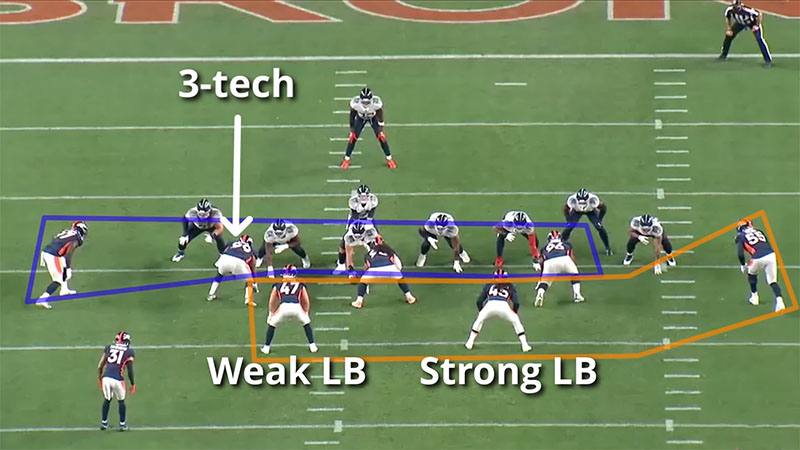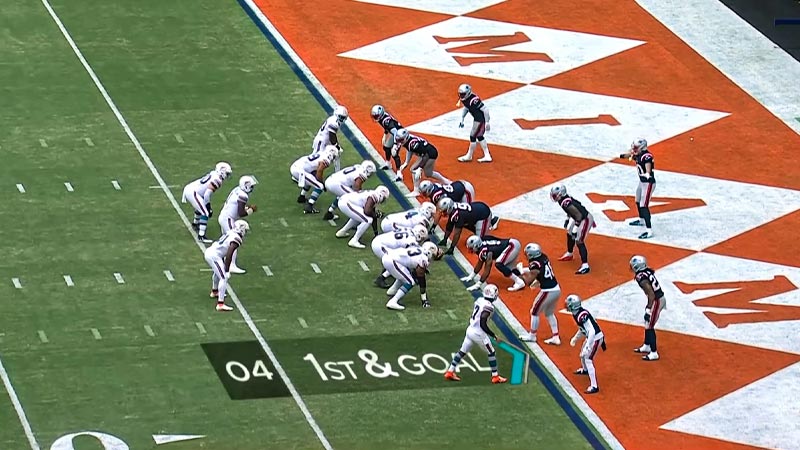In the intricate world of football, defensive formations serve as the backbone of a team’s strategy, meticulously crafted to thwart the opponent’s offensive maneuvers.
These preplanned arrangements of players on the field are the result of keen analysis by defensive coordinators, who consider factors like the opposing team’s tendencies, down and distance, and specific game situations.
By understanding these formations, teams can effectively counteract offensive plays and gain a competitive edge.
The 4-3 formation, one of the most traditional alignments, features four defensive linemen and three linebackers, offering a balanced approach to both run and pass defense.
This setup aims to exert pressure on the quarterback while providing robust support for various defensive responsibilities, such as run-stopping and coverage.
As the game evolves, so do the strategies, with formations like the 3-4, 5-2, and nickel defense, each offering unique advantages tailored to specific scenarios on the field.
Football Defensive Formations list
There are a lot of defensive formations in American football. Here are the 20 most important defensive formations:
1. 4-3 Defense

A 4-3 defense uses four down linemen and three linebackers, prioritizing balance in run and pass defense. Commonly called a base defense, it’s often employed on first and second downs.
This setup allows flexibility, combining strength upfront with agile linebackers for coverage. Defensive coordinators leverage it to combat various offensive strategies, adjusting as needed.
2. 3-4 Defense
The 3 4 defense features three down linemen and four linebackers. It’s known as a base defense due to its adaptability. Teams switch to formations like nickel or dime as required.
Focus is placed on versatility and flexibility for successful engagements. Linebackers, essential to this formation, adapt quickly to changing offensive plays. This setup allows strategic advantages in diverse situations.
3. 4-4 Defense
The 4 4 defense employs four down linemen and four linebackers, resembling a strategy that strengthens both run stopping and pass coverage.
Heavily utilized in high school and amateur levels, this formation is known for its straightforward execution and adaptability. With enhanced pressure on the offensive line, teams using the 4 4 can control the line of scrimmage effectively.
Linebackers in this setup have vital roles, often tasked with blitzing or covering short passes. Adjustments within this formation allow for a dynamic response to various offensive strategies.
4. 5-2 Defense
The 5 2 defense in American football places five down linemen upfront. Two linebackers support the front line.
This alignment strengthens run defense by adding an extra lineman, creating a solid barrier against rushing plays.
Teams often implement this setup in short-yardage situations, ensuring robust penetration to counter strong offensive lines.
5. 6-1 Defense
Rooted in the 4-3 defense, the 6-1 defense adapts to counter modern spread offenses. It positions seven defenders in the box, emphasizing run stopping and pass defense.
This setup offers heightened pressure on offensive plays, aiming to disrupt execution. Defensive coordinators strategically use this formation to combat specific offensive strategies, enhancing defensive flexibility.
6. 4-2-5 Defense
The 4-2-5 defense utilizes four linemen and two linebackers. Creativity defines this setup by featuring five defensive backs, including a specialized nickelback.
It’s especially effective against passing offenses, prioritizing secondary coverage while maintaining pressure.
Defensive coordinators employ this scheme to counter versatile offensive formations, adapting strategies as game situations demand.
7. 3-3-5 Defense
The 3 3 5 defense includes three down linemen, three linebackers, and five defensive backs. Teams often leverage this setup to counterspread offenses with extra defensive backs.
Flexibility allows for rapid adjustments, enhancing pass defense without compromising the run. In this formation, linebackers provide multi-role capability, adapting to opposing plays effectively
8. 3-2-6 Defense
The 3-2-6 Defense is a specialized formation designed primarily to defend against the pass. With three defensive linemen, two linebackers, and six defensive backs, it maximizes coverage in the secondary.
The three linemen aim to generate pressure on the quarterback, while the additional defensive backs provide extensive coverage against the pass.
This formation is often utilized when opponents are likely to rely heavily on passing plays, such as during two-minute drills or in third-and-long situations.
The 3-2-6 Defense prioritizes speed and coverage skills, aiming to disrupt passing lanes and limit the effectiveness of aerial attacks.
9. 4-1-6 Defense
This formation prioritizes strong secondary coverage with one linebacker supporting four linemen. Defensive backs, numbering six, enhance versatility for countering passing plays.
The defense effectively limits deep passes and spreads. Coaches prefer it against teams with aggressive passing offenses.
Strategic positioning of players optimizes coverage and pressure, creating an adaptable yet robust defense.
10. Nickel Defense
Nickel Defense is a strategic football formation employing five defensive backs: two cornerbacks, two safeties, and a nickelback.
This setup counters offenses heavy on passing plays. Coaches use it to match up better against teams with three or more wide receivers.
Opponents deploying additional wide receivers prompt defenses to add the nickelback, replacing a linebacker, enhancing pass coverage while potentially aiding run support too.
11. Dime Defense
The Dime Defense uses six defensive backs, featuring two safeties and four cornerbacks. It’s designed for passing situations, countering medium to long-range plays.
Typically, defenses use this formation when the running game is weak or time is limited. Its strategic advantage lies in neutralizing threats like Hail Mary passes, prioritizing goal-line defense.
12. Quarter Defense
Quarter defense features seven or eight defensive backs. It excels in extreme passing scenarios, like preventing Hail Mary passes. Utilization of seven defensive backs uses 3-1-7 or 4-0-7 formations.
An eighth back, often a wide receiver, appears in 3-0-8 formations. This setup enhances interception chances, crucial during predicted high-risk plays.
13. 4 6 Defense
The 46 defense, an American football formation, uses an aggressive eight-men-in-the-box strategy.
Six players align along the line of scrimmage, providing enhanced pressure on the offensive line. Defensive coordinators leverage this setup to disrupt running plays while creating opportunities for sacks.
14. Bear Defense
The 46 Bear defense prioritizes pressure to disrupt offensive strategies. It stops the run effectively, compelling quarterbacks into poor throws.
This formation places eight defenders in the box, usually with six on the line, creating discomfort for offenses. Designed to apply constant pressure, it forces turnovers and errors.
15. Prevent Defense
Prevent defense focuses on stopping long passes and touchdowns on single plays. It often sacrifices some short-yardage gains to run out the game clock effectively.
Defenses leverage this alignment in critical moments to counter deep-threat offenses. Teams strategically position defensive backs to maintain coverage over larger field areas. Known for its situational use, this formation is crucial in high-stakes scenarios.
16. Goal Line Defense
In football, goal line defense is crucial. It often determines game outcomes. This defense prevents offenses from scoring when they’re inches away from the end zone.
Linemen close gaps, and linebackers prepare to tackle any ball carrier. Defensive backs maintain tight coverage on receivers.
This strategy relies on anticipation and teamwork. Teams often adapt based on offensive formations to optimize their defensive setup.
17. 3-3-5 Eagle Defense
The 3-3-5 Eagle Defense integrates flexibility with coverage. In this setup, three down linemen and three linebackers anchor the formation.
Five defensive backs enhance pass coverage. This alignment prioritizes defending against spread offenses.
Rapid adjustments enable adapting to various offensive threats. Versatility in player roles supports both run and pass defense.
Linebackers often cover slot receivers or blitz. The Eagle Defense effectively counters quick passing plays and maintains line integrity.
18. 3-1-7 Defense
The 3-1-7 Defense stacks three linemen for pressure. One linebacker supports them, monitoring short zones. Seven defensive backs provide pass coverage, suited for deep threats.
Defensive coordinators deploy this setup against spread offenses, prioritizing coverage. The arrangement enhances interception opportunities during critical passing situations.
19. 3-2-5 Defense
The 3-2-5 defense features three linemen and two linebackers. Designed to counter spread offenses, it enhances pass coverage with five defensive backs.
Teams favor this setup for its adaptability, allowing shifts to various formations as plays develop. Linebackers in this formation play versatile roles, often dropping into coverage or blitzing when necessary.
20. 2-4-5 Defense
The 2-4-5 defense prioritizes agility and coverage. Two defensive linemen anchor the formation, focusing on penetrating offensive lines.
Four linebackers enhance versatility by adapting to run or pass plays. In this setup, five defensive backs, crucial for pass coverage, counter air attacks effectively.
Coordinators choose this formation to handle spread offenses and increase interception chances, providing flexibility in dynamic game situations.
Importance of the Football Defensive Formations

Importance of the Football Defensive Formations
Football defensive formations are essential tools that allow teams to counteract offensive plays effectively. They’re crucial for adapting to various game scenarios, enhancing a team’s strategic approach.
Strategic Flexibility
Defensive formations enable teams to modify strategies based on opponents’ strengths and weaknesses.
Coaches have the flexibility to select formations that counter specific offensive styles, like a running game or strong passing attack.
Stopping the Run or Pass
Different formations target specific game aspects. The 4-3 or 3-4 formations are effective at halting run plays, while nickel or dime formations excel in pass defense. Changing formations based on game situations ensures defensive success.
Personnel Utilization
Formations help in maximizing defensive personnel utility. Teams with strong linemen may use formations focusing on a solid front, while those with a potent secondary might opt for formations enhancing pass coverage by adding more defensive backs.
Down and Distance Considerations
Formations reflect considerations of down and distance. Near the end zone, goal-line formations are employed when the offense is close to scoring, while prevent defenses are used during pressing passing situations.
Adaptation to Trends
Football evolves, and so do offensive strategies. Defenses must adjust to trends like spread offenses or increased passing emphasis. Staying ahead of these trends is vital for maintaining defensive effectiveness.
Creating Mismatches
Coaches use formations to create mismatches against opponents. Nickel or dime formations are employed against multiple-receiver sets to match defensive backs’ speed and coverage skills to receivers.
Game Situation Management
Managing game situations relies heavily on defensive formations. Prevent defenses protect leads in late-game scenarios, while aggressive strategies like blitz-heavy 3-4 formations might be used to force turnovers or quick stops.
Red Zone Defense
Preventing touchdowns in the red zone often involves unique formations. Teams balance defending against both runs and passes within confined spaces to stop scoring.
Psychological Impact
The presence of diverse formations can psychologically affect opposing offenses. Unpredictability and adaptability in defense lead to uncertainty, increasing the likelihood of offensive mistakes, thus demonstrating the strategic value of defensive formations in football.
Wrapping Up
Football defensive formations are a cornerstone of strategic gameplay, offering teams the ability to counter various offensive tactics effectively.
Each formation, from the traditional 4-3 to the innovative 3-2-5, serves a specific purpose, allowing defensive coordinators to anticipate and adapt to their opponents.
By understanding the strengths and weaknesses of each setup, teams can tailor their defenses to maximize their chances of success on the field.
As the game continues to evolve, so too will these formations, ensuring that defenses remain a pivotal aspect of football strategy.







